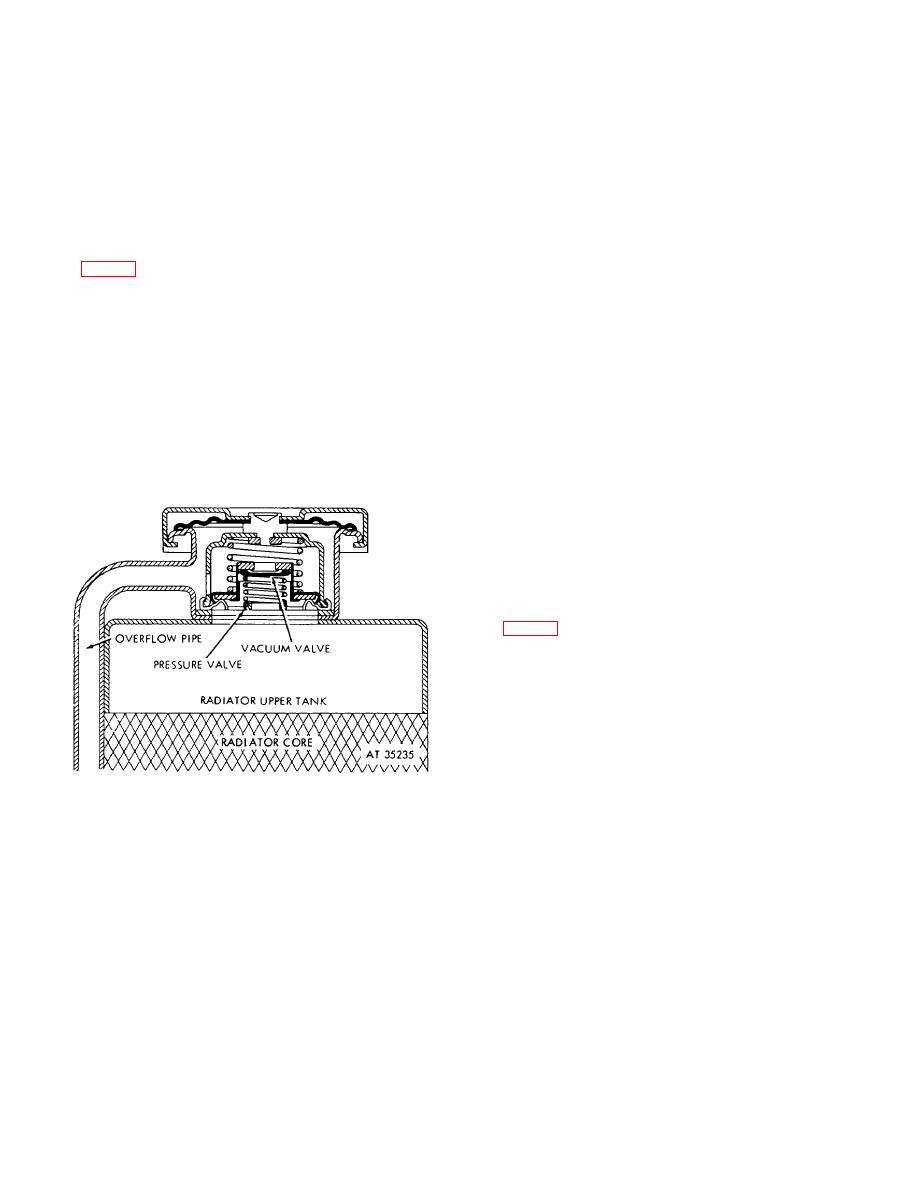 |
|||
|
|
|||
|
Page Title:
Radiator Pressure Cap |
|
||
| ||||||||||
|
|
 d. Core Function In the radiator core, a large
(2) Vacuum-valves The vacuum valve opens only
amount of heat is rapidly transferred from the cool ant into
when pressure within the cooling system drops below
the air. Through the water tubes, the flow of coolant is
outside air pressure as the engine cools down. Higher
divided into many small streams which causes a small
outside pressure then forces the valves open, which allows
amount of cooling liquid to be exposed to a comparatively
air to enter the system by way of the overflow pipe. When
large cooling surface in the tubes. This results in rapid
pressure inside and outside again becomes approximately
flow of heat from the coolant to the tubes and air fins Heat
the same the vacuum valve closes. This automatic action
is carried away from the tubes and fins by the air moving
of the vacuum valve prevents collapse of hose and other
through the core
thin-walled parts of the cooling system without internal
support.
1-10.
Radiator Pressure Cap
c.
Operation of Pressure System
a. General. The radiator pressure cap contains two
(1) When a system is equipped with a pressure cap
spring-loaded normally closed valves. The larger valve is
it is generally referred to as a pressure-cooling system.
called the pressure valve and the smaller one is called the
The radiator used in such a system is especially designed
vacuum valve. A shoulder in the radiator filler neck
to withstand extra pressure. Tightness of all connections
provides a seat for the bottom of the cap assembly and a
and joints is particularly important since pressure naturally
gasket on this seat prevents leakage between the cap and
aggravates any existing leakage. An airtight cooling
the filler neck. By closing off the overflow pipe opening,
system is necessary to obtain the benefits of pressure
the pressure cap prevents overflow loss of coolant during
cooling.
normal operation. It also allows a certain amount of
pressure to develop within the system which raises the
(2) Except under the heaviest driving conditions or in
boiling point of the coolant and permits the engine to
extremely hot weather, most military engines can be
operate at higher temperatures without coolant overflow
operated without pressure in the systems. However, in
from boiling.
some vehicles normal operating temperature is always
above the boiling point of the coolant. Proper functioning
of the pressure-cooling system is absolutely necessary to
avoid large overflow losses of coolant from boiling, even
under average operating conditions.
1-11.
Radiator Overflow Tank
a. General. Radiator overflow tanks, sometimes
called surge tanks or expansion tanks, are standard
equipment for some vehicles. They are Installed on other
vehicles as special equipment for operation in hot or dry
country. The overflow tank serves as a receptacle for
coolant overflowing from the radiator and provides for its
return to the system. Thus, the overflow tank conserves
coolant and reduces the need for frequent filling of the
radiator.
Figure 1-5. Radiator pressure cap - cross-sectional view.
b. Construction.
Overflow tanks may vary in
b. Function
capacity from 2 quarts to a gallon or more. They are
(1) Pressure valve The pressure valve acts as a
usually mounted fairly high with reference to the cooling
safety valve to relieve extra pressure within the system. In
system. The bottom of the tank is connected to the
the majority of transport vehicles, the pressure valves
radiator overflow pipe through a metal tube which is
open at about 4 pounds per square inch. When the valve
usually connected by short pieces of flexible hose. When
is forced open, it allows steam and coolant to escape
the cooling system is equipped with an overflow tank, the
through the overflow pipe until the pressure drops below
pressure cap is placed on the tank rather than on the
its opening point. Four pounds pressure in the cooling
radiator, and a plain cap is used on the radiator. This cap
system will prevent overflow loss from boiling of water until
arrangement leaves the overflow pipe open to the tank.
a coolant temperature of about 225F (at sea level) is
The plain cap on the radiator must always be pressure-
reached.
Some vehicles have valves with opening
tight to permit
pressures as high as 17 pounds This pressure raises the
boiling point of water to about 255F.
1-5
|
|
Privacy Statement - Press Release - Copyright Information. - Contact Us |